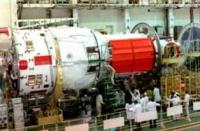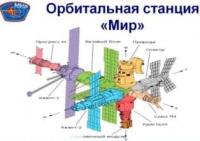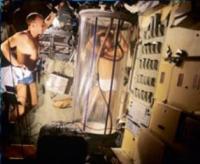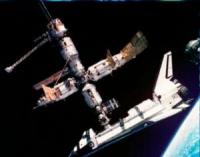You are here
Life and death of MIR station.




Manned flights from Baikonur Cosmodrome.
“Space is space. There is nothing like it on Earth."
Gennady Padalka.
Manned flight program from Baikonur Cosmodrome.
The development of multi-purpose manned orbital complexes and means of their transport and technical support makes it possible to solve the problems of accelerated testing in space conditions of instruments and systems of promising spacecraft, to obtain new results in the field of medicine, biology, space technology, to work out the processes of assembly and maintenance of objects in orbit, to conduct scientific research. research and experiments, implement joint projects with foreign countries.
On the night of February 20, 1986 (00:28:23 Moscow time), the manned space station "Mir" was launched from Baikonur, which operated for more than 15 years - a record only recently surpassed by the ISS. This orbital station entered the history of Russian cosmonautics as the last Soviet and first Russian.
Until recently, it held the record for the duration of work in orbit - a decade and a half, and many of its other records have not been broken to this day. The Mir station, a unique engineering object of the 20th century, completed 86,331 orbits around the Earth during its existence of 5,511 days.
Over the 15 years of operation, more than 30,000 scientific experiments were carried out at the station, and 104 cosmonauts from 12 countries visited it. In this sense, the experience of operating the Mir orbital complex, the construction of which began on February 20, 1986, is unique.
Work on the creation of the Mir orbital space complex began in the Soviet Union in 1976. The first 20-ton base module of the Mir station was launched into orbit on February 20, 1986. In the spring of 1987, the Kvant-1 module was launched into orbit. It became a kind of space station for Mir.
The docking with Kvant became one of the first emergency situations for Mir. In order to securely attach the Kvant to the base complex, the cosmonauts had to make an unplanned spacewalk. In June 1988, the Kristall module was delivered into orbit.
An additional docking station was installed on it, which, according to the designers, should serve as a gateway for receiving the Buran ship. Over the course of 10 years, four more modules were docked to the orbital station, one after another: the Kvant-2 retrofitting module (in 1989), the docking-technological "Kristall" (in 1990), the research "Spectrum" (in 1995 -m) and scientific research “Nature” (in 1996).
The first people on the Mir were Soyuz-T-15 crew members Leonid Kizim and Vladimir Solovyov. Their ship had an outdated docking system and therefore docked not to the front, but to the rear port leading to the station's power compartment.
But overall it was an incredible flight. Soyuz-T-15 docked to Mir, the cosmonauts brought the station into working condition, and after a month and a half they undocked and flew to the Salyut-7 station, which was also in orbit at that time.
They spent another month and a half on the Salyut, after which they returned to the Mir. In fact, these were the first flights in history between space stations. Inside the base module we have equipped everything for a comfortable life.
The crew regularly communicated with relatives, watched films, trained on sports equipment and organized bath days. “Once a week you could go to the sauna, they even brought oak and birch brooms from Earth. We really took a steam bath,” recalled Toktar Aubakirov, Honored Test Pilot of the USSR.
In 1991, the international era of the world's first multi-module orbital station began. The Spectrum and Priroda modules were funded by NASA (thus, Mir became, in essence, an international space station). This radically changed the purpose of the Spectrum.
It was originally called "Oktant" and was developed by the Chelomey Design Bureau as a defense ship equipped with interception missiles. In 1992, the Cold War had already ended, and the project was financed by an American agency, so its military purpose was forgotten and the module became exclusively research.
In addition, in November 1995, the seventh module, a docking adapter for shuttles, was delivered to Mir. It was mounted on the Crystal block, which became the main entry point for American ships. Cosmonaut Valery Polyakov set a record on Mir for the duration of stay in space during a single flight from January 8, 1994 to March 22, 1995 - 437 days and 17 hours 58 minutes.
Cosmonaut Viktor Mikhailovich Afanasyev made three flights to the Mir station with a total lasting 545 days. In December 1993, as part of the Banner project, a unique experiment was carried out: with the help of deployed reflective panels, it was planned to illuminate certain areas of the Earth with sunlight.
In order to master outer space, reveal the secrets of the Universe and comprehend the depth of meaning of the Universe, one must overcome a lot of steps. And every new step is dangerous. Flights into space always involve great risk for the crew.
Staying on the space station is also unsafe for astronauts, and sometimes serious accidents have occurred. I would like to note that during all emergency situations in orbit no one was injured. Let's talk about some of them.
In 1997, the station almost suffered a disaster several times. In January, there was a fire on board - the astronauts were forced to put on breathing masks. The smoke even spread aboard the Soyuz spacecraft. The fire was extinguished a few seconds before the decision to evacuate was made.
And in June 1997, the unmanned Progress cargo ship went off course and crashed into the Spektr module. The station has lost its seal. The team managed to block the Spectrum (close the hatch leading into it) before the pressure at the station dropped to a critically low level.
“Spectrum” had the largest area of solar panels and provided up to 40% of the station’s energy, so its loss was virtually irreplaceable. Therefore, in recent years, even almost no scientific work has been carried out on Mir.
On August 28, 1997, another problem happened at Mir. In the evening, shortly before lights out, the Electron hydrolysis unit, which produces oxygen, spontaneously switched off. The malfunction was identified in just a few minutes (it turned out that some kind of contact had broken), and already at half past ten the normal supply of oxygen to the station was restored.
In September 1997, as a result of a computer error, Mir lost orientation to the Sun. To carry out astronomical observations of the Sun, Moon, planets and stars, it is necessary to orient the telescopes or the entire station accordingly.
Solar collectors of the power supply system must be constantly directed towards the Sun. And therefore, having lost the desired direction, the station was left without the main source of energy. Also, a certain orientation is necessary for various antenna devices, which means that control was lost, since the crew could not accurately find out the location of the station.
24 hours passed before control of the station was restored. According to the cosmonauts themselves, each of the station’s systems could fail at any moment. Initially, Mir was designed for approximately five years of continuous operation, but by the end of the XXth century it worked for as much as 15 years.
The Mission Control Center decided to first transfer the station to unmanned mode. On June 16, 2000, the last expedition, consisting of the crew of Sergei Zaletin and Alexander Kaleri, returned from Mir on Soyuz-TM-30. Alexander Kaleri was the last to close the Mir hatch. He recalls:
“I unexpectedly had a personal farewell to the station. On the ship I sat in the left seat. There is a porthole in front of me. When we left Mir, the Soyuz began to move slightly to the side and it turned to the station on its left side. For several minutes I watched in fascination as we left. Forever. I said goodbye to her because I understood that I would see her for the last time. It was very sad..."
At the end of 2000, the Government of the Russian Federation issued Resolution No. 1035 “On the completion of the operation of the Mir orbital manned complex” due to obsolescence of equipment and lack of financial resources for its maintenance.
In the space field, the USSR actually had a controlled artificial Earth satellite capable of carrying a permanent crew, carrying out continuous observation of any earthly objects, and conducting scientific and military research.
Direct costs for developing the program and creating the main base unit amounted to 4.2 billion. dollars. The actual launch of the base unit took place 10 years later, on February 20, 1986, and cost 1.6 billion. The planned retrofitting of the station with scientific modules (Kvant-2, Kristall), carried out by 1990, cost another 1 billion 100 million dollars.
Considerable funds also went through the budget: 1986 - 375 million, 1987 - 393 million, 1988 - 461 million, 1989 - 595 million. The assembly was completed after the Priroda research module docked with it on April 26, 1996.
Over the years of operation of the complex, 31 manned spacecraft of the Soyuz type and 64 transport ships of the Progress series were sent to it. The average annual cargo flow to Mir was 15 tons. However, perestroika soon began, and budget money stopped coming. 1999 - 24 million, 1991 - 6.1 million, 1992 - 8.7 million, 1993 - 22 million dollars.
According to the original plan, the station was supposed to be equipped by 1993, but in reality this did not happen. The last of the modules, “Nature,” was docked only in 1996. And until 1992, a completely unfinished complex flew in orbit.
There wasn't enough money. This is where the Americans appeared. In 1993, an agreement was signed with the United States on the joint operation of Mir, after which international crews began working on it. In 1993, Americans alone invested 73 million dollars in Mir, in 1994 - 131 million, in 1995 - 54 million, in 1996 - 60 million.
Others paid too. In particular, the flight of the Slovak cosmonaut to the station alone brought in about 16 million dollars. n 1996, the time required to permanently repair the station tripled. And after another three years, the Khrunichev Center did not issue permission to continue its operation at all.
A new owner for the Mir station will soon be found. The Dutch entity "Mir Corp" took the lease. From 1995 to 1998, joint work was carried out with the United States within the framework of the Mir-NASA and Mir-Shuttle projects.
During this time, 9 dockings of the Shuttle spacecraft with the Mir orbital station took place. In total, during the existence of Mir, 28 main crews worked on board, and 22,000 experiments were performed. The flight of the Mir station became the greatest achievement of Russian cosmonautics.
Initially they had serious plans. Mir has its anniversary in February. He is very old. Older than all orbital complexes created on Earth. He turns 15 years old. There is no larger project in the world. It is no coincidence that Denis Tito, an American businessman who will apparently become the first space tourist, first of all asked to go to Mir, but, unfortunately, did not have time.
It will be able to be released into space on April 30 at best. However, everything comes to an end and in 1997 a brand new ISS appeared in orbit and all interests focused on it. In 1998, the Mir station found itself in a critical situation.
According to agreements signed at the government level, Russia was obliged to provide funds, pilots and transport ships for work on the ISS program. Otherwise, our share in it (only 7%) would simply be taken away for debts.
As a result, resources capable of supporting our Mir began to go to something other than our ISS. Over 15 years of continuous operation, Mir has withstood more than 100 dockings, including with the Shuttles, which were not best suited for this.
More than 80 cosmonauts visited it, there were several major accidents, one fire. During a planned docking with the Progress M-34 transport ship (June 25, 1997), a serious collision occurred with depressurization and disabling of the Spektr module, which did not I worked for two more years.
An objective analysis of the technical condition of the complex showed that the further continuation of the Mir flight does not provide the required level of reliability and safety. In this regard, as well as in connection with the start of the manned stage of work on the ISS in December 2000, a decision was made to complete work at the station, the result of which was the controlled descent of the Mir complex on March 23, 2001 at the estimated time in a given area of the World ocean.
The last symbol of socialism that has not lost its pride, the Mir station, was previously supposed to be sunk in the Pacific Ocean on March 8, but in fact the flooding occurred on March 22, 2001. The main task now is to coordinate the drift of the station so that there is fuel left for the last flight - falling into the Pacific Ocean, not far from the coast of Australia.
This is a kind of space cemetery, the last harbor where the remains of spaceships sunk over the years of space exploration rest. There are more than a hundred cargo Protons here alone. The pun “to find a quiet haven in the Pacific Ocean” is not without grace.
"The world" is dying half of its life. By old age he became a piggy bank of cosmic diseases. Sealing problems, solar power problems, communication problems. There are problems even with keeping it in orbit. "Mir" decreases daily by 750 meters. The Mir station weighs 137 tons.
On March 23, 2001, the station was deorbited. At 05:23 Moscow time, the Mir engines were given the order to slow down. At around nine in the morning, Mir entered the atmosphere several thousand kilometers east of Australia.
Most of the 140-ton structure burned up upon re-entry. Only fragments of the station reached Earth. Some were comparable in size to a subcompact car. The fragments of the Mir fell into the Pacific Ocean between New Zealand and Chile.
This colossus will pick up such speed that if it falls on the city, the consequences will be much more serious than with a nine-magnitude earthquake. Tunguska meteorite, only small. But the force of the impact will be such that, according to the BBC, fragments of the station are capable of penetrating a two-meter layer reinforced concrete.
The wave would spread across the earth's crust for tens of kilometers. The surviving houses would have flared up with torches, taking up the baton from the blazing station. In reality, most of the “Mir” burned down in the atmosphere and the earth received only 40 tons of scattered fragments.
Passengers on two planes witnessed the fall of hot debris into ocean waters. Tickets for these unique flights cost up to 10 thousand dollars. Among the spectators were several Russian and American cosmonauts who had previously visited Mir.
With its existence, the Mir station proved that the construction of complex multi-module composite objects in Earth orbit is possible. The International Space Station, the first segment of which was launched into orbit on November 20, 1998, became the successor to Mir.
Russia abandoned the further operation of the Mir station in favor of developing its segment on the International Space Station. The construction of the ISS began with Russia joining the program: at that time, Russian engineers had the most experience in creating composite stations, or rather, no one except our specialists had such experience.
Authority and photos by
https://bgkm.ru/virtualnye-meropriyatiya/1488-stantsiya-mir-15-let-na-orbite







